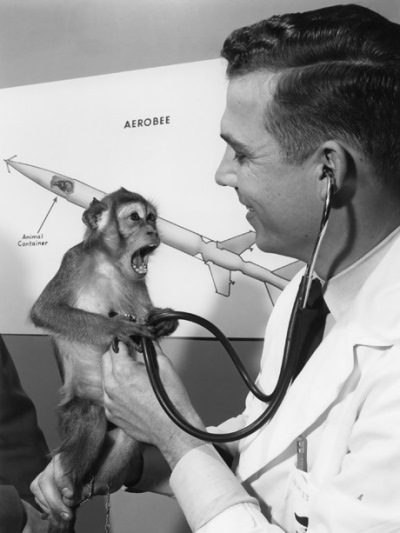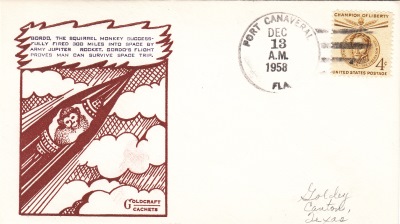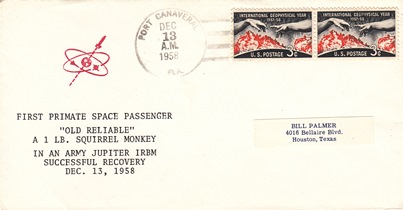Space cover made by Bill Palmer, Houston, Texas, for the epic flight of Space Monkey "Old Reliable," December 13, 1958. For many of us, the monkey's space flight is one of the earliest space covers for the United States' space program. 
Space Monkey "Old Reliable" is shown during his workup with his Trainer for his test flight in a Jupiter IRBM prior to December 13, 1958, from Cape Canaveral, Florida, down the Atlantic Missile Range.
Space Cover #500: Space Monkey "Old Reliable"
"We all heard the rumors that they wanted to send a monkey up first. Well,none of us wanted to think that they were gonna send a monkey up to do a man's work ... what they were trying to do to us was send a man up to do a monkey's work," the quote is attributed to Deke Slayton, Mercury Seven Astronaut.
"Old Reliable" was one of the first monkeys to make it into space as part of the early space program. Eight monkeys had flown on earlier space missions before, him, five of whom were named "Albert."
One of the monkeys was given the nickname of "Old Reliable" because he had far better reactions than the others. When placed in his space capsule, he usually went right to sleep. He was never excited or disturbed by the confining capsule metal tube or the array of straps and measuring devices attached to him. Because of his fine space personality, we chose "Old Reliable" to make the upcoming space flight.
Here is how Captain Norman Barr MD USN described his early space monkey "Old Reliable" when he was suited up. The early space monkey wore a specially fitted space suit custom made for a monkey about one foot tall. The space suit was fitted with instruments, including temperature meters and microphones which recorded his historic suborbital journey, and considered one of the outstanding achievements of space research.
After launch and flight, Captain Norman Barr went on to make a bold prediction: During the entire 8 minutes and 20 seconds of gravity-free space flight. "Old Reliable's" responses did not once waver from complete normalcy. The astounding truth was that nothing happened. The first primate ever to arch through space for an appreciable period of time was hardly affected by his experience.
"Old Reliable" was one of the first monkeys sent into the space. He had traveled further than any monkey had ever traveled before. Unfortunately he died because his spacecraft parachute module had failed to open.
Captain Barr further added, This spaceflight was of immense significance to man. With a single exception, "Old Reliable" was experiencing the same physical conditions man would one day know in space. We had every reason to believe that man's reactions would be essentially the same."
The exception, of course, was that man will think about what is going to happen to him. He would be much more excited than a squirrel monkey, and he would not be likely to take a nap during the 30 minutes before take-off. The first space man's knowledge of his role would surely increase the magnitude of his reactions, but I do not believe the increase would be intolerable.
Thanks to "Old Reliable," we can now say with virtual certainty that man is physically capable not only of rocket take-off but of sustained, gravity-free flight through space.

A second space cover is shown for "Old Reliable" after his name had been changed to Space Monkey "Gordo" with the cover published by space cover maker George Goldey of Canton, Texas.
I would also like to thank Space Unit Member Ken Havekotte who has provided the following information about the name "Old Reliable":
"Old Reliable" was also the nickname of America's first large ballistic missile, the Redstone, developed and first flown by the U.S. Army's Wernher von Braun,s rocket team during the early 1950s.
The Redstone rocket became known as the "Father of American ballistic missiles" as the Redstone rocket laid the groundwork for upcoming advances in U.S. missile and rocket technology.
Many thanks, Ken, for this additional information.
— Steve Durst, Space Unit 4379













